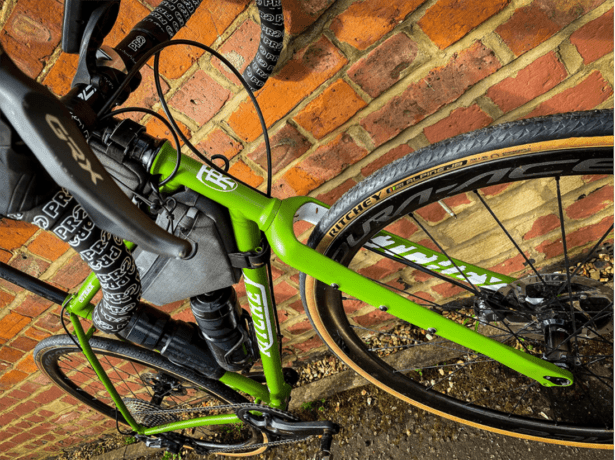Shimano designed their GRX groupset primarily for gravel and adventure riders. But, its wide range of options gives it the versatility to be used by cyclocross rider and bike packers too.
But components of the Shimano 105 groupset are also used for off-road riding. The Shimano GRX groupset costs $****, while the 105 comes in at $***, but which one is best for you?
In this post, I am going to go through the differences to help you decide which groupset is best suited to your needs.
Shifters
The Shimano 105 shifters are very similar to the Shimano Dura-Ace and Ultegra items, with the new-style hood shape, flattened tops, and lightly textured covers.
The overall profile of the 105 levers has been updated, with a more pronounced curve for your index finger, making it easier to brake from the drops.
You change to a larger gear by flicking the brake lever inward. And to go to a smaller gear, you flick the additional shifter behind the brake lever.

The action is very light and gives you precise shifting. The improvements in this new system make the shifting action you get from the 105 almost indistinguishable from the more expensive Ultegra.
Shimano offers both mechanical and electronic shifters for the GRX groupset. But, the GRX shifters are different from the 105, as they are more suited for riding on rougher terrain.

The hood is taller, to give you a more secure hand position when riding the rough stuff, while the levers are textured, allowing you to easily maintain your finger position when riding over bumps.
This design gives you much more control and comfort over other shifters in the Shimano range.
Riders that opt for the Di2 shifters will benefit the most from the new design. As the electronic parts take up less space than the mechanical version, resulting in a very comfortable hood shape, that curves in a way that gives you a more secure grip and more control.
Rear Derailleur
The Shimano 105 groupset allows you to run a wide range of gears. The RD-R7000-GS derailleur can go up to a 39t cog, which will give you the lowest possible gear ratio from a 105.
You can now buy 105 cassettes in 11-25, 11-28, 11-30, 11-32t ratios, alongside the wide-range CS-HG700 11-34t cassette, which is compatible with 10-speed freehub bodies.
This derailleur doesn’t feel quite as crisp or quite as well made as Shimano’s higher-end groupsets.
However, the shifting from the 105 is light, predictable, and fast. One of the improvements of the previous model is the low profile construction, which puts it safely under the chainstay.
The rear derailleurs in Shimano GRX groupset, all use Shadow RD+ technology, which stabilizes the chain, which is very important when riding over rough terrain.
It does this by minimizing unnecessary derailleur arm movement, providing more secure chain retention. In turn, you get less chain slap, a quieter ride, and uninterrupted shifting performance.
The GRX derailleur sits further underneath the cassette than traditional road derailleurs, this makes it less exposed, reducing the likelihood of damage from undergrowth and rocks.

Their reliable design keeps them working perfectly, even in the muddiest conditions.

Front Derailleur
The new style derailleur you get with the Shimano 105, can present you with a challenge when working out the cable routing.
If you opt for this system, make sure you follow the manual properly when installing it. However, once you have it sussed, everything will become apparent quickly, especially when it comes to fine-tuning it.
Shifting feels exceptionally light, and very similar to the Ultegra, due to its speed and precision. The new design of the Shimano derailleurs does away with the long actuation arm, we saw on previous models.
As with the rear derailleur, you can have mechanical or electronic shifting on the GRX’s front derailleur. It has an extra clearance of 2.5mm, so you can use it on bikes with wider tires, up to 42mm.
Therefore, you need to make sure that your new front mech matches the corresponding GRX chains, which is also pushed outwards by 2.5mm.
Chainset/Crankset
Stiff chainsets make you’re pedaling more efficient, and Shimano is well known for the stiffness of their chainsets.
All Shimano chainsets now use the same asymmetric 110mm BCD (bolt circle diameter), meaning you can easily upgrade or alter your combination to suit your personal preferences. But this design ensures that you get strength where it is needed the most.
The 105 features the Shimano two-piece bonded alloy construction and a 24mm axle, so it is compatible with bottom bracket standards.
However, you get the same bottom threaded bracket found in the Ultegra groupset. The advantage of this is that it is sealed much better than the previous model, but the press-fit version remains the same.
You can get the 105 R7000 cranks in 53/39-, 52/36- and 50/34-tooth chainring options. It is even possible to get an Ultegra 46/36 version, and a Dura-Ace in 55/42t and 54/44t ratios.
When it comes to the GRX, you can choose from three different chain sets.1×11-speed, 2×11-speed and 2×10-speed.
The GRX 800 series chainset is available 2x with 48/31-tooth chainrings, and 1x with either a 42-tooth or 40-tooth chainring.
The GRX 600 series chainset is available 2x with 46/30-tooth chainrings, and 1x with a 40-tooth chainring.
The RX600 10-speed chainset with 46/30-tooth chainrings.
The main difference between the GRX 800 and 600, is that the 800 uses Shimano’s Hollowtech II crank arm technology, which reduces weight. You will notice the 1X chainsets use Shimano’s Dynamic Chain Engagement tooth profile.
The design is similar to what you see on mountain bikes with tall teeth that are alternately thick and thin and specially shaped, this prevents the chain from bouncing off on rough terrain.
Brakes
Shimano offers both rim and disc brakes for the 105 groupsets. The rim brakes have been significantly improved over the previous incarnation, as they are more powerful and give better modulation.
The clearance on the caliper has also been increased, so it can take a 28mm tire and even a mudguard.
For those of you that want to go for the disc brake version, you will find it difficult to tell the difference between the 105 and the higher-end models. They give you loads of braking power, with superb feeling, giving you excellent control.
You will experience these fantastic braking characteristics throughout the Shimano range. But the extra pad clearance means that when you are riding gravel or in muddy conditions, you won’t have to put up with noise coming from the pads rubbing on the rotor.
If you think you will be using the 105 for riding long descents, you may want to opt for the Ice Tech-equipped rotors and pads. The Ice Tech system copes extremely well with high-speed descents and scrubbing the speed off tight corners. They do this by dissipating heat to improve braking performance while looking pretty cool too.
The GRX brake levers are textured to provide more grip with wet hands or with gloves. You also get additional inline brake levers mounted near the stem.

The idea behind these is to increase your options of positioning your hands, so you can be in a more comfortable position when riding on technical terrain and not be on the drops.
The flat-mounted brake calipers are the same design as the current road calipers. The only difference is that they have GRX logos, therefore, they have one-way bleeding and the Ice Tech pads and rotors.
The calipers and rotors are flat-mounted and are the same design as the Ultegra items, meaning braking performance is powerful and consistent.
Shimano’s ST-RX815 Di2 levers improve braking further, as they use the Servo Wave technology, which you will find on Shimano’s mountain bike brakes.
This gives the brake lever more progression, by giving the first part of the lever travel a very light feel, but and the brakes respond instantly. The feel of the levers makes them very easy to modulate the braking power when the terrain gets rougher.
Overall
The improvements in the design of the Shimano 105 groupset, give you components that have a very similar feel and performance characteristics of more expensive items.
If weight, is an issue for you, you may want to save up and spend a little more on the higher end Ultegra version. But, the 105 is a very dependable and more affordable option.
With the GRX groupset, Shimano has given adventure and gravel riders some excellent options to equip their bikes with. The GRX range will suit most riders that like to ride on more than just roads.
Both systems are reliable and have a quality feel to them. Another advantage of both of these groupsets is that you will be able to choose between a lot of options when it comes to replacing worn-out components.
Also, if you just fancy a change, there is a good chance you will be able to find a decent alternative component at a reasonable price.
Braking and gear shifting performance are excellent on both groupsets, but if you are riding off-road often, you will want to go for the GRX.
The GRX is intended for off-road use, so it will give you a more secure feeling, as your hands stay firmly on the hoods, and you will be able to bake and change gear, even when they are cold, wet and muddy.

Tom Fortune has been reviewing cycling products for several years from his home in the French Alps. As the owner of mtb-threads.com, he mainly reviews mountain bike products but also reviews road cycling products independently.




very helpful review information
Why did he use the word “but” unnecessarily?